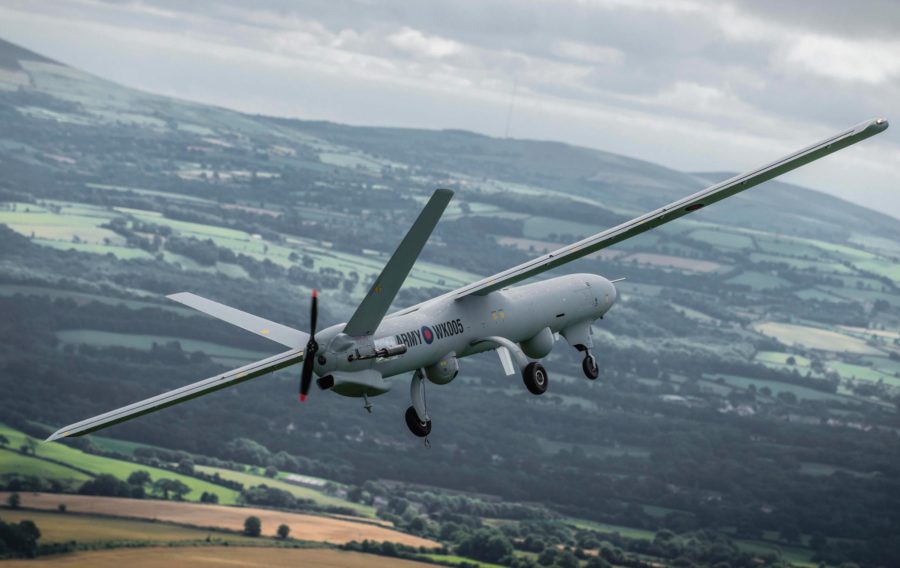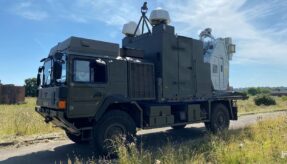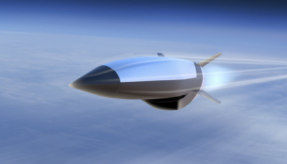
Watchkeeper was the first unmanned aerial vehicle required to be built to the same safety standards as a manned aircraft. MOD DCB features writer Paul Elliott spoke to Barry Trimmer, Technical Director at Watchkeeper manufacturer Thales, about the Watchkeeper platform and the broader UAV marketplace.
We’ve been told to expect to see unmanned aerial vehicles (UAVs) regularly in the skies for some time now, whether it be for commercial or security use. The potential for UAVs to be used in a variety of domestic scenarios is clear but there has to be confidence in the safety of the platforms for this to happen. Improving the regulation and safety of UAVs is therefore a big issue. Within industry there is a lot of interest in developing areas such as ‘sense and avoid’ and the safe entry of UAVs into civil airspace. Entering civil airspace requires higher standards and expectations of UAVs, which will be, and are being, implemented.
Watchkeeper was the first UAV to qualify to new high-safety standards – it is built to the same standards as a manned aircraft. It was also the first UAV to be successfully flown alongside manned aircraft in civil controlled airspace, and is further the only certified platform of its class able to undertake such a flight. The flight, which took place in September 2015, saw Watchkeeper fly from West Wales Airport into civil controlled airspace for an hour, where it was successfully managed by the National Air Traffic Service (NATS), the UK air navigation services provider, for the first time.

The flight formed part of Project Claire, a collaboration between Watchkeeper manufacturer Thales, NATS, the Dutch National Aerospace Laboratory (NLR), the UK Ministry of Defence and the UK Civil Aviation Authority (CAA), and was joint funded by the SESAR Joint Undertaking.
Barry Trimmer, Technical Director at Thales, is proud of this success. He said: “The purpose was to demonstrate taking a military registered UAV into controlled airspace in an airplane. Watchkeeper was a good candidate because it has a safety qualification at the same safety standard you’d find in manned aviation. Watchkeeper is a good aircraft to use as something that can go into that airspace if you put special measures in place to manage the conflict.
“It’s not normal yet, but I think it will become normal that UAVs will be able to be deployed through and in unsegregated airspace, because they will have to be.”
It is hoped the success of Project Claire will help develop the necessary operational and regulatory conditions to support a growing need for unmanned aircraft systems to be used in commercial, search and rescue, homeland security tasks, critical infrastructure and border protection.
Watchkeeper was the ideal piece of kit to use for this, but where did its journey start in regard to its safety standards?
Mr Trimmer explained: “I guess it starts from the fact that Watchkeeper was the first UAV to be given a specific safety target. It’s usual for manned systems to have this but very unusual for unmanned systems. There was a requirement to meet a safety target so we had to look at all the systems, break them down to achieve the safety target, and then prove it –
and this takes a lot of years and safety meetings.
“We were pleased with the fact that despite fairly wholesale changes in regulations, the architecture we put in place back in 2003 is still the architecture we have today, and it’s an architecture that is able to pass those safety tests.
“The key thing is to get the architecture right at the beginning. If you’re half way through a multi year development programme and you have to change the architecture then it’s like you have to start again.”

Watchkeeper, being the first in this respect, is something of a feather in Thales’ cap. Mr Trimmer acknowledges that it is indeed good to be a pioneer, but he says you learn a lot of lessons along the way and sometimes they can be painful. It does, however, put Thales in a good position to know how to get a UAV through a safety case to that standard. With much change on the horizon in regard to regulation, Mr Trimmer predicts the market will heavily segment.
UAVs like Watchkeeper, a half-tonne vehicle that flies fairly high, will have to meet the full
regulatory standards. It is hard to predict, though, what kind of regulation will be applied to UAVs below 25 kilos in weight, where it’s almost a hobbyist thing. In this case Mr Trimmer expects society will accept safety standards that probably won’t be as high as you’d expect from manned aviation and the large UAVs.
The military use of smaller UAVs will probably follow the regulation approach. So a small UAV that doesn’t go out of line of sight will require a different set of standards to those which apply to a large UAV that operates beyond line of sight. The big changes will be in the small UAV sector because of the number of people potentially using easily accessible small UAVs.
Watchkeeper itself is a system in an interesting phase in its product lifecycle. Thales has ambitions to export the platform, which is currently being deployed by the UK MOD. Its core capability is that it’s basically an ISTAR (intelligence, surveillance, target acquisition and reconnaissance) platform.
It is arguably the most deployable aircraft and system on the market with dual payload and reasonably long-range capability. There is interest coming from the Middle East and across Europe for that kind of capability. What a lot of people perhaps don’t realise is that Watchkeeper is manufactured by a largely UK supply chain.
Mr Trimmer commented: “The supply chain is mostly UK; there are a couple of pieces outside the UK but it has been set up as a UK supply chain, and that was part of the reason I believe Watchkeeper was awarded to us.
“We generated a UK supply chain as we went through the process. When we developed the case for Watchkeeper and put it into practice, what we did was ensure it was manufacturable, supportable and upgradeable from within the UK. It’s all good for UK plc.”
For Thales, UAVs are an expression of its ability to understand what the customer wants and its ingenuity in getting out of technology what the customer needs. Mr Trimmer says the company understands how to do large projects, how to build relationships within large projects, and how to deal with issues that are beyond the traditional equipment line of company interaction; and this is what the company plans on pursuing into the future. He foresees there will be more projects that require a strong interaction between the company and the way the customer and user do business.
The boundaries of that are likely to change.
Mr Trimmer added: “I think in the future we’ll see more of a relationship where we use our skill set to provide more services to the customer and the user. It’s all about the interaction between ourselves and the customer and user at a fairly high level to try and solve problems. In UAV terms we see Watchkeeper as a system that will continue for a couple of decades now as a developmental project.
“It continues to increment forward with the customer’s requirements, and equally importantly we also see it as part of the overall UK Unmanned Aerial Systems (UAS) team. There’s quite a lot of development to be done across UAS between ourselves and Protector and others. There’s some commonality of interests and commonality of developments that we have to deal with, not least of which is going back to ‘sense and avoid’ and the civil UAS side of life. Many projects will have to solve that problem for the MOD and it will be sensible to solve it in a kind of similar way. The whole issue of airspace access is significant for the MOD across a bunch of UAS projects. It’s not really good doing it on a project-by-project basis.”
Unmanned aerial vehicles have been used widely for military operations for some time, and this will only continue. Watchkeeper has certainly played its role in making UAVs safer as we move towards their wider deployment, particularly in civil airspace. The predicted future world of UAVs operating in all manner of roles in the civil realm might be nearer than you think.
If you would like to read more articles like this then please click here
controlled airspace NATS Project Clare SESAr Thales UAV UK Watchkeeper








